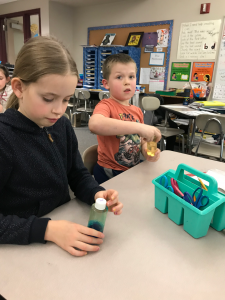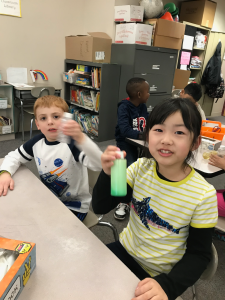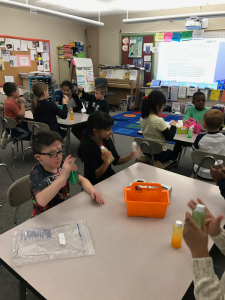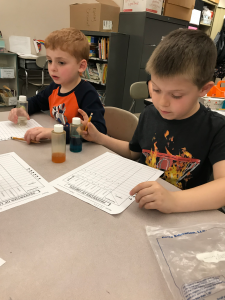Posted by kavery508 | Posted in Uncategorized | Posted on April 23, 2018
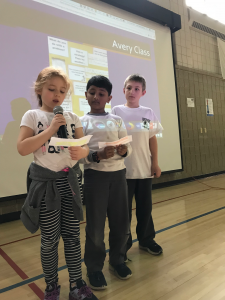 Our school meeting Friday was a big success! The theme was centered around emotional problem solving using the book What Do You Do With a Problem? (Yamata). Students in our class created a bulletin board showcasing common problems kids face at school, plus multiple solutions since we know a growth mindset means persevering and finding more than one way to solve problems. We then presented the board at school meeting and engaged the audience of our peers! You can see the book read aloud here: https://www.youtube.com/watch?v=HG25YyKJ4qs
Our school meeting Friday was a big success! The theme was centered around emotional problem solving using the book What Do You Do With a Problem? (Yamata). Students in our class created a bulletin board showcasing common problems kids face at school, plus multiple solutions since we know a growth mindset means persevering and finding more than one way to solve problems. We then presented the board at school meeting and engaged the audience of our peers! You can see the book read aloud here: https://www.youtube.com/watch?v=HG25YyKJ4qs

With just 9 weeks to go, students will learn to use technology to communicate and evidence their thinking through the use of student learning blogs! They will learn to navigate online environments, including posting, commenting, and replying; to create, find, and upload media such as images and audio files; and to collaborate with peers through reading and writing. This week, we will learn what it means to be part of an online community and how safety rules of common sense apply there as well as in real life. Then we will learn what a digital footprint means and how to create a safe one, as well as how to stay safe online. A note on safety and privacy: Student blogs are created via Kidblog.org. They are only open to invited peers and teachers. Once up and running parents will be invited to view them as well with a private password. For more information, please visit their site. Lessons on privacy and more are taken from Common Sense Media.
 This week, students will learn to comprehend nonfiction text by paying close attention to titles, subtitles, and headings when reading informative articles. These nonfiction text features are used by author’s to guide our thinking, and they lead us to understand the most important things worth remembering. You can try it out at home with articles from NationalGeographicKids.com, such as this one on Denali National Park. Notice how the headings cleverly point us in the direction of what’s important.
This week, students will learn to comprehend nonfiction text by paying close attention to titles, subtitles, and headings when reading informative articles. These nonfiction text features are used by author’s to guide our thinking, and they lead us to understand the most important things worth remembering. You can try it out at home with articles from NationalGeographicKids.com, such as this one on Denali National Park. Notice how the headings cleverly point us in the direction of what’s important.
 This week we begin Chapter 14, which teaches kids to tell time to the 5 minutes on an analog clock; write the time in numbers or words; correctly identify AM and PM; and solve problems involving elapsed time (minutes or hours later/before). Check out the graphic above: students are being taught to identify time using the hour and minute hands; to tell minutes of any hour by counting “5s” around the clock; and to use those skills to calculate time elapsed. Here is a link to a great online clock from ABCya.com that kids can manipulate to read the time in analog and digital format, and to use it to play games. Try it out! Just navigate to this page, select “Practice,” and click “GO”: http://www.abcya.com/telling_time.htm
This week we begin Chapter 14, which teaches kids to tell time to the 5 minutes on an analog clock; write the time in numbers or words; correctly identify AM and PM; and solve problems involving elapsed time (minutes or hours later/before). Check out the graphic above: students are being taught to identify time using the hour and minute hands; to tell minutes of any hour by counting “5s” around the clock; and to use those skills to calculate time elapsed. Here is a link to a great online clock from ABCya.com that kids can manipulate to read the time in analog and digital format, and to use it to play games. Try it out! Just navigate to this page, select “Practice,” and click “GO”: http://www.abcya.com/telling_time.htm
And here’s a great song we’re using to help us tie it all together, from Readeez:  In science this week students will explore water in different containers to learn about prominent features of liquids: their levels remain parallel to the earth, and their molecular structure causes them to take the shape of the container they are in. Here are some shots of us exploring a variety of liquids to learn more about their properties!
In science this week students will explore water in different containers to learn about prominent features of liquids: their levels remain parallel to the earth, and their molecular structure causes them to take the shape of the container they are in. Here are some shots of us exploring a variety of liquids to learn more about their properties!

